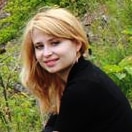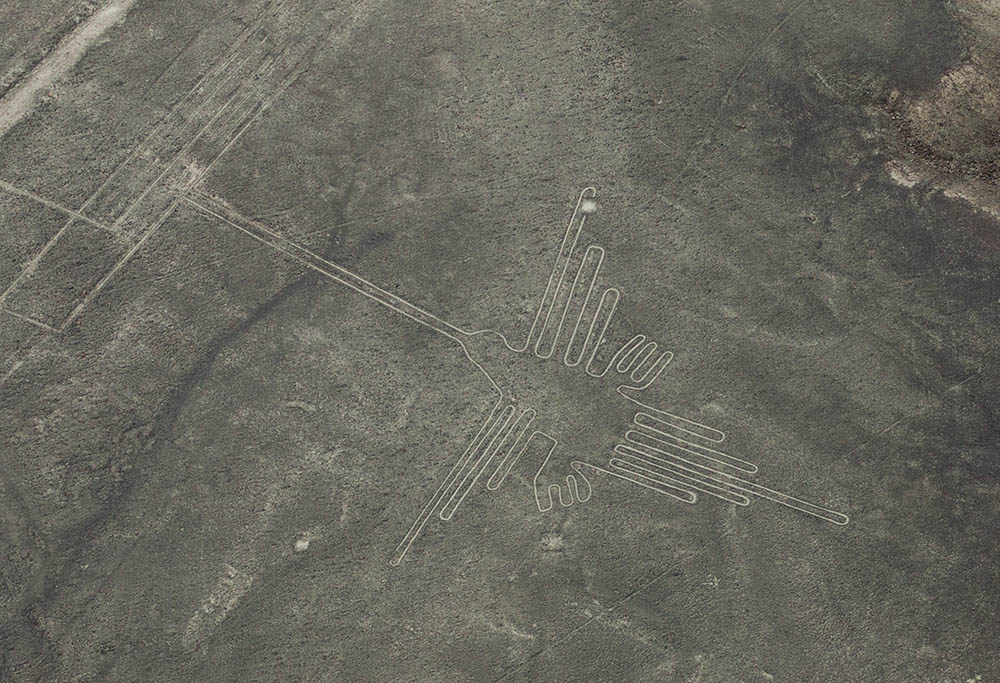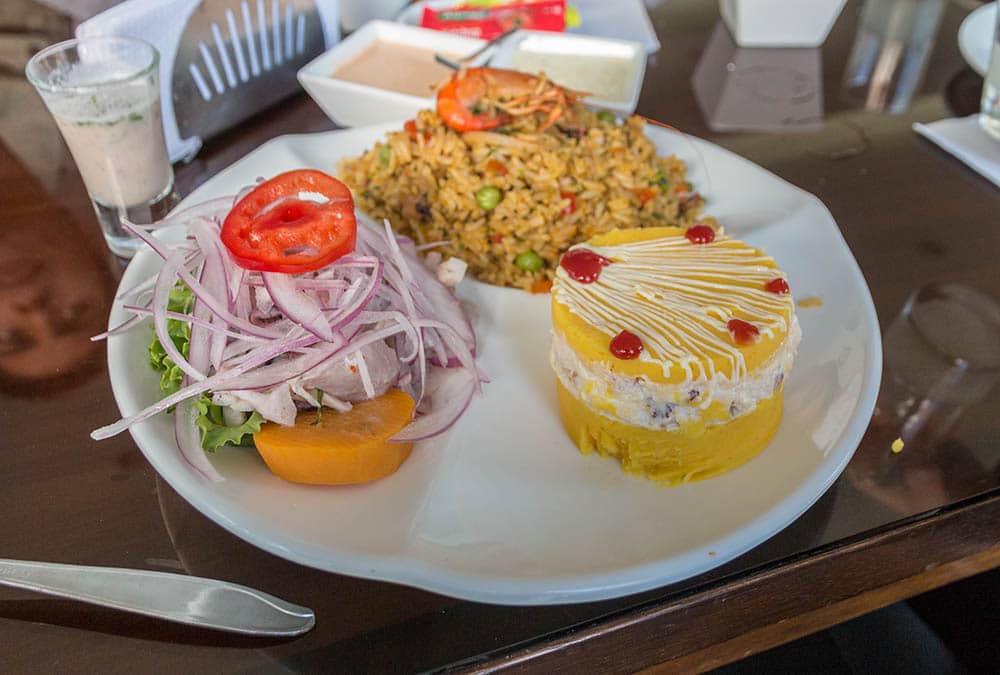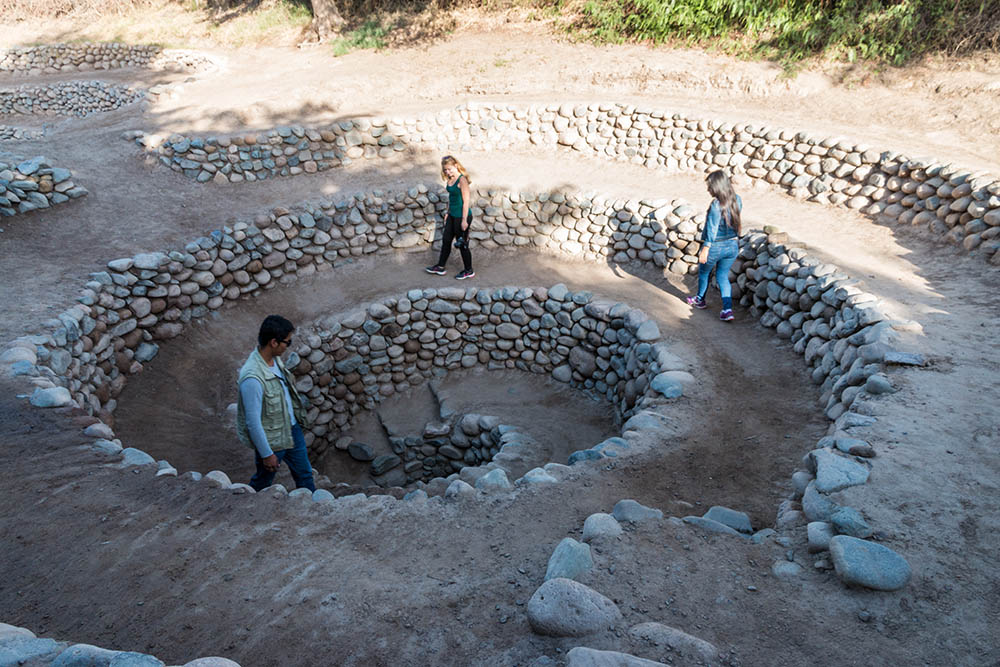The enigmatic Nazca Plain remains a subject shrouded in mystery for many scientists to this day. Probably everyone would be able to recall the huge lines and shapes engraved into the desert that can only be seen from above. Few people, however, know that Nazca has much more to offer. Such as ancient aqueducts that still work to this day or Indian graveyard where mummies several thousand years old have been discovered.
The Nazca culture is one of the most important civilizations before the Incas themselves. It reached the greatest prosperity during 200-600 AD. What caused this civilization to crumble remains unclear to the scientists to this day. But one thing we are certain about. The Indians of the Nazca culture left behind many traces that raise a number of questions that are quite hard to answer.
As our guide in Nazca, we chose the company Peruvian Mysteries. The likeable Luis and his beautiful girlfriend Nohelia spent the entire day with us and were our guides around the sights we so longed to see. Luis picked us up at the bus station and took us all the way to our hotel. For the next day, he arranged a flight over the Nazca plain as well as a visit to the aqueducts and the Indian burial grounds. Luis and Nohelia truly were the nicest companions and we really enjoyed the mutual exchange of cultural customs. After a short while, we felt as if we were travelling with friends. Luis had a large car; he drove us around the landmarks and acted as our guide. He was a very generous and pleasant companion. They both prepared a very pleasant day for us that we both enjoyed very much.
Flying above the Nazca plain
The Nazca plain is famous for its mysterious lines, triangles, and geoglyphs representing animals, which stretch over a vast area of several hundred square kilometres. The images have been preserved for several millennia and there are more than 300 of them. They were discovered in the early 20th century during a plane expedition of the area. To this day, the scientists still have no idea what purpose could the lines and geoglyphs have, as they can only be seen from above. There are several theories; one of them making the lines an enormous calendar and other a landing runway for aliens. At present, scientists are most inclined to believe that the images were engraved for religious purposes. It could perhaps be some way of paying respect to their gods. Scientists also agree that the Indians had to have an amazing grasp on mathematics to be able to create designs so large and accurate without having a chance to actually see them.
Luis picked us up at our hotel in the morning and took us to a small airport, from which the flights are organized. We waited for almost three hours for the flight itself, because the clouds in the area were quite low. Luis told us that it is quite common during the winter period. Several airlines operate at the airport and because all aircraft fly at the same height, it’s necessary to draw up a flight plan first. And if the weather happens to be bad when you arrive, you might have to wait for a couple of hours. Fortunately, we didn’t really mind waiting, because we had a whole day to visit Nazca. What supposedly often happens, however, is that tourists buy their bus tickets back for noon and actually miss the flight. So it’s necessary to consider possible delays. Luis and Nohelia helped us pass the time waiting for our flight; we discussed possible theories of why and how were the patterns created.
The flight was really something. Respectively the first half. There were six passengers on the plane and each of us had a seat by a window. The pilot made sure that everyone had a chance to see the lines from the best possible angle. So the little plane turned to all sides, spun and circled so that no one would miss out on anything. The lines were perfectly visible. The whole plain was literally dotted with lines, triangles, and geoglyphs like a notepad. Unfortunately, during the second half of the flight, we all got motion sick from the flight manoeuvres. But after landing we found out that it’s actually quite common and most people feel really sick during the flight. So get ready for it, because even we felt sick and our stomachs are pretty strong.

In the afternoon Luis took us to a place where he explained how exactly the lines on the plain were created. Entering the area where the lines are is punishable by up to five years’ imprisonment, but there is a possible way to get closer and examine them from a relative proximity. Luis took us to a raised hill from where we were able to see one picture up-close. The images themselves are formed by light-coloured lines on a dark volcanic surface. The Indians actually only moved the dark stones, under which the lighter coloured land remained, creating the lines of the patterns. It wasn’t any scratching or engraving of rock as we originally thought. Only moving the dark stones aside to expose the light-coloured ground underneath them.
Probably the most impressive thing that we saw was the cactus farms. All around the paths, cacti fields full of opuntias grew. Curious, we asked Luis what the locals use the cacti for. He replied that a small beetle that produces a distinctive red dye called carmine lives on the opuntias. This dye is widely used in the food industry and cosmetics. We immediately ran over to look at the tiny insects up-close. Luis explained that the beetles have to be dried first and the red colour is then extracted from them using some kind of a chemical process.
Chauchilla – burial site of Indian mummies
Luis and Nohelia were waiting for us at the airport and immediately after we landed and put ourselves together, we set out to visit an ancient Indian burial site. The drive there took about half an hour. Chauchilla is a cemetery located in a desert, which was built around 200 AD. Mummies of the Indians buried there were discovered in an absolutely perfect condition, even though this site was a frequent target of thieves and grave robbers.
The corpses were stuffed with cotton, wrapped in solid fabric and buried in tombs crouched in prenatal position. Luis explained that the Indians believed in the afterlife, so they prepared their dead for what awaited them next. This is also the reason why they buried them in tombs with valuables as well. He explained that the mummies are perfectly preserved thanks to the hot and dry climate of the harsh Atacama Desert, but also the solid brick structure of the tombs. One thing that’s worth noting is the hair of each and every mummy. Very long, dark and without a single grey hair. Even several thousand years after death.
For lunch, we went with Luis and Nohelia to a nice nearby restaurant. They gave us tips about local dishes that are typical for Peruvians; we really enjoyed the cooked fish and seafood risotto. Luis also took us to several other places that we had no idea existed. One of them was an old ceramic workshop where the owner made the ceramics exactly the same way the people of Nazca culture did a thousand years ago. He very willingly showed us what kind of material he uses for creating pots and what colours he decorates them with. Another interesting place was the archaeological excavation site of old fortifications built by the Incas themselves. Luis explained that the Incas occupied a very wide area and lived even there.
Cantalloc – aqueducts that work to this day
The Nazca civilization inhibited very dry areas where the need for water was constant. At present, the Atacama Desert is one of the driest places on Earth. Yet there is a rich source of water underground that the Indians used to their advantage. They built an underground system of ancient aqueducts, also known as puquios, which work to this day. Luis explained that the aqueducts used to spread over a much larger area than today and were used as a source of water for agriculture. It was quite difficult for the Indians to pull the underground water all the way to the surface, so they created a sophisticated system of water tunnels that transported the water exactly where it was needed. They probably used the wind to create enough pressure to propel the water. The spiral wells served as maintenance shafts and were probably protected by a hatch in the past. We were able to admire the painstaking work of the Indians from up close and see that they carefully handcrafted every detail. The stones are stacked on top of each other with the utmost precision and Luis even showed us that the clean water runs through the tunnels to this day.
The day we spend with Luis and Nohelia was very pleasant and we would most certainly recommend the services of Peruvian Mysteries to anyone visiting the area. Nazca is an absolutely picturesque place, full of history and with a mysterious past. With a local guide at your side, you won’t miss out on any interesting fact or place. It’s definitely worth it to spend a whole day in Nazca because there is much to discover. For us, the biggest advantage was the transport. Some sights are located more than several dozen kilometres from each other and Luis took us wherever we needed to go in his car. This meant we didn’t have to worry about transport, which would otherwise be one of our main concerns.
Contact
Phone: (051) 01950657964
Website: www.peruvianmysteries.com
Email: info@peruvianmysteries.com
Address: Cajuca Mz D5 LT.8-Nasca
Tripadvisor
Thanks to Peruvian Mysteries for support during our visit in Nazca. All our views are based on our own experience.
Liked this post? PIN IT FOR LATER!!
















I did an over flight on the nazca lines with http://www.nazcatrips.com it was wonderful, a unique experience. Also visit the chauchilla cemetery and the aqueducts of cantalloc. It is highly recommended to know Nazca.